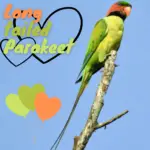
Nicobar Parakeet (Psittacula caniceps) 56–61 cm 224 g. Bill read above, black below; head pale grey with a black frontal band extending to the eye and broad black band from lower mandible and chin to sides of the neck,
sometimes extending as very faint pale brown collar round hindneck; rest of body grass green, tail tinged yellowish-grey and tipped yellowish. Nicobar Parakeet Female has head strongly tinted blue, upper mandible black. Immature undescribed.
Description
At 61 cm in length (of which more than half is its long, pointed tail), the Nicobar Parrot is the longest member of the Psittacula genus.
Nicobar Parakeet plumage is green except for its head, which is gray, with two black stripes on the front of its face, one from eye to eye across the forehead and another wider one that occupies the throat and the lower sides of the head.
It has a strong bill and is very curved downwards. The bill of the males is red with a yellow tip, while that of the females is blackish.
Systematics History
Monotypic.
Subspecies
Monotypic.
Distribution
Nicobar Is: on Great and Little Nicobar, Menchal and Kondul.
Habitat
Nicobar Parakeet live Tall forest.
SOURCE: G V Sumesh
Movement
Sedentary.
Diet and Foraging
Ripe fruits of Pandanus are extensively used.
Sounds and Vocal Behavior
Not well documented. Vocalizations overall loud and raucous, including a crow-like drawn-out “krraah”. Also a steeply upslurred “shrek!” and a modulated “shee-wack!”.
Breeding
No information from the wild. A Nicobar Parakeet egg laid in captivity measured 38·2 mm × 25·6 mm.
Conservation Status
Not globally threatened. CITES II. Currently considered Near Threatened. A BirdLife “restricted-range” species. Apparently common; many Parakeets are caught for the local cagebird trade, but much habitat remains on the islands.




















